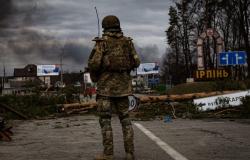The war in Gaza has already exceeded 200 days. In recent weeks, attention has mainly focused on the south of the Gaza Strip, where more than a million Palestinians fled before the fighting. But Israel is planning a ground offensive in the area. An Oxfam humanitarian worker from Rafah describes the situation directly on the spot.
What you will also hear in today’s episode at 5:59
- According to the humanitarian worker Fida Al-Arajova, the situation in the south of the Gaza Strip is at a time when Israel is preparing a ground invasion in Rafah.
- How significant a factor is the lack of food in the area and the threat of hunger, which is also pointed out by the UN.
- And why, after the conclusion of a possible ceasefire, another battle awaits the Gaza Strip – this time for its renewal.
He says that he and his family sometimes go through weeks where they have to make do with canned food, pulses or dried food. At that moment, it is impossible to think about the variety of the diet or its nutritional value. It’s just about not being hungry.
“You reduce food to its basic function – you eat to survive,” says Fidá Al-Arajová from the city of Rafah in the south of the Gaza Strip. He describes a whole range of problems with finding food – from its lack in markets to high prices to difficulties in accessing cash in the Gaza Strip. “You spend a lot of time and your mental capacity thinking about food: What am I going to cook today? Where and how do I get the ingredients for it?” he adds in an interview for the 5:59 podcast.
The mother of six works as a coordinator for the humanitarian organization Oxfam. But she herself belongs to the refugees. The stay in Rafah marks the end so far of her family’s journey, which began in mid-October when they were forced to flee their home in Gaza City, in the northern Gaza Strip.
In the south, however, they found similarly difficult conditions, although the war had so far ravaged the area less. You can also get more food in Rafah.
“In the case of the south of the Gaza Strip, it is not a matter of famine, but here too it is a threat – according to reports, ninety percent of the local people are at risk of its imminent outbreak,” says Al-Arajova, adding a personal experience: “We have been searching for some food in vain for many weeks – or is it still we are still looking. For example, it is only a few days since we ate an apple for the first time in six months since the war began.’
According to Al-Arajová, the situation is also a great psychological burden for the children, who at the beginning of the war first lost their schooling, but gradually other circumstances, including hunger and malnutrition, affect them with great intensity. Parents cannot provide them with a stable environment and often not even answers to their questions. “They (children) are constantly scared and live in anticipation of the worst,” the Palestinian aid worker points out. And he points out, among other things, that according to UN estimates, 19,000 children lost their mothers during the war and became orphans.
Complex life in tents
The south of the Gaza Strip is not the first stop on the refugee journey of the Fida Al-Araj family. In total, she had to move four times.
He also describes the conditions in Rafah as “appalling”. And above all for those refugees who live in tents. Due to lack of space, they often had to build them on sand. All this often in places without running drinking water, electricity or toilets connected to sewage. The cold weather did not add to the comfort in the tents in the winter, and with the arrival of the spring and summer months, mosquitoes and scorpions. In addition, according to her, some diseases spread among people, such as jaundice.
All this means that from the point of view of Fida Al-Arajova, it is definitely not possible to talk about good living conditions. “In fact, these are conditions in which it is impossible to live,” he emphasizes.
She said she herself was lucky enough to find accommodation with an acquaintance after arriving in Rafah with her family. They are currently renting an unfinished house where, for example, there were no windows or doors.
Photo: archive of Fida Al-Arajova
Coordinator of the humanitarian organization Oxfam in the Gaza Strip, Fidá Al-Aradzová.
Aid from planes “doesn’t make sense”
Meanwhile, the UN warned in March that if the food supply does not improve, the majority of the population of the Gaza Strip is at risk of starvation by the end of May. In the following weeks, Israel announced that it had allowed more humanitarian aid trucks into the war zone.
However, Fidá Al-Arajová recalls that before the war, about 500 trucks a day headed to the Gaza Strip with permission from Israel. However, according to her, it is currently only about half. And humanitarian supplies dropped into the Gaza Strip from the machines of the US Air Force and other countries are not even aid that would be more noticeable.
“I observed with my own eyes one scene when the sky was full of military planes, which at that moment were bombing the area below. And in the middle of it all, there was a military plane that got permission from the Israelis and was dropping food. I didn’t understand it,” says the Oxfam coordinator, adding that aid dropped from planes “looks nice and like a heroic act”, but it doesn’t make much sense. And she compared the whole scene to the movie Hunger Games.
Return to normal impossible?
The Israeli government, led by Prime Minister Benjamin Netanyahu, still plans to send its ground forces to Rafah. And it states that the last battalions of the Islamist organization Hamas are hiding in the area. It was the bloody attack by Hamas last October that marked the beginning of the current war. At the same time, however, in recent weeks and months, the pressure of the international community to conclude a ceasefire has been growing.
Photo: Anas-Mohammed, Shutterstock.com
The city of Rafah in a picture taken this March.
According to Fida Al-Araja, the ceasefire must come as soon as possible, preferably immediately. But at the same time, he points out that after its closure, another challenge will come – to put the Gaza Strip back on its feet. But it will be a matter for many years.
However, a return to the old ways will probably not be possible. “It seems to me that the feeling of being uprooted cannot be reversed. I don’t think I’ll ever be able to get over this feeling in the rest of my life,” reflects a woman from the Gaza Strip. He emphasizes that the war not only killed thousands of people, but also destroyed the cities and streets that people knew well and where they grew up. This is also why Al-Arajova does not expect that life after the end of the conflict will be considered normal. “That is completely out of the question,” he adds.
In the 5:59 podcast, you will also learn about the problems Oxfam faces when trying to get humanitarian aid to Gaza, or how even before the war, according to Fida Al-Araj, life in the area was far from ideal. Listen in the player at the beginning of the article.
Editor and Co-Editor: Matej Válek, Eduard Freisler
Sound design: David Kaiser
Podcast 5:59
The news podcast of Lenka Kabrhelova’s team. One essential topic every weekday in minute six. The most important events in the Czech Republic, in the world, politics, economy, sports and culture through the lens of Seznam Zpráv.
You can find an archive of all parts on our website. Write us your observations, comments or tips via social networks or by e-mail: [email protected].
Tags: Testimony Gaza Hunger Games bombing dropping food time
-






